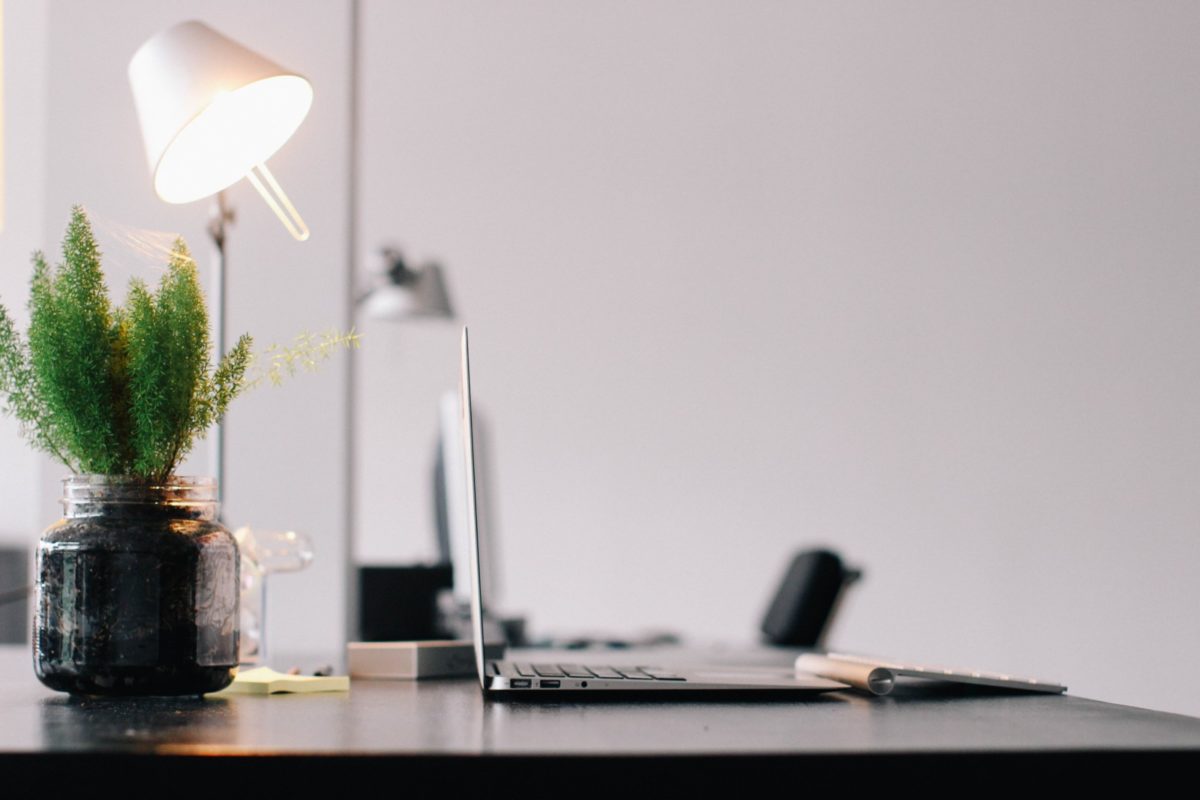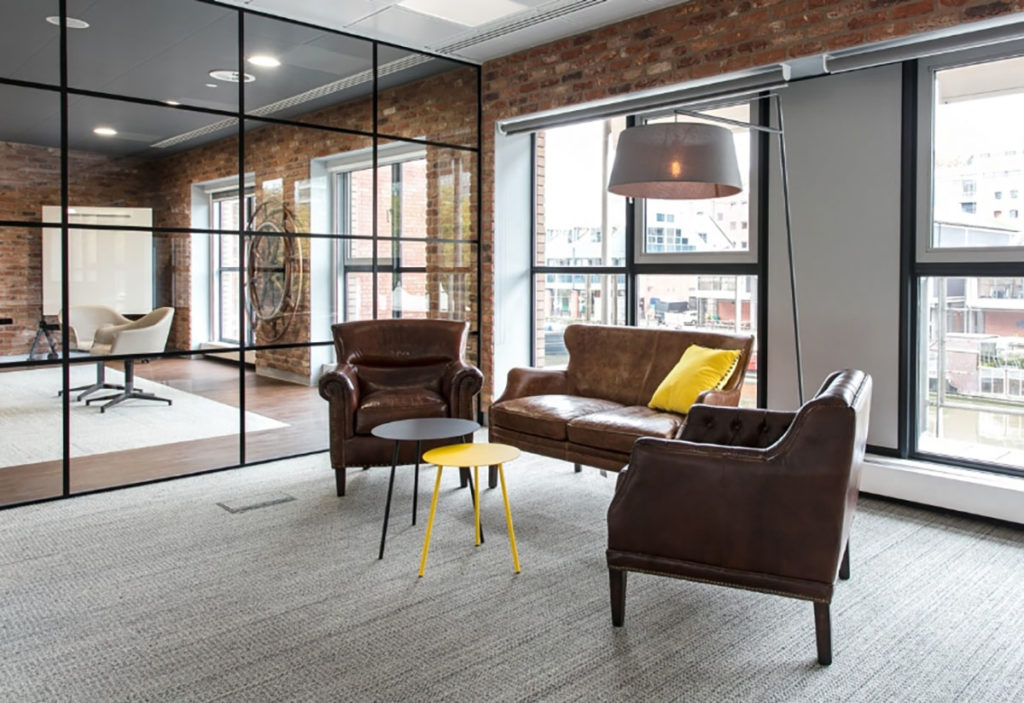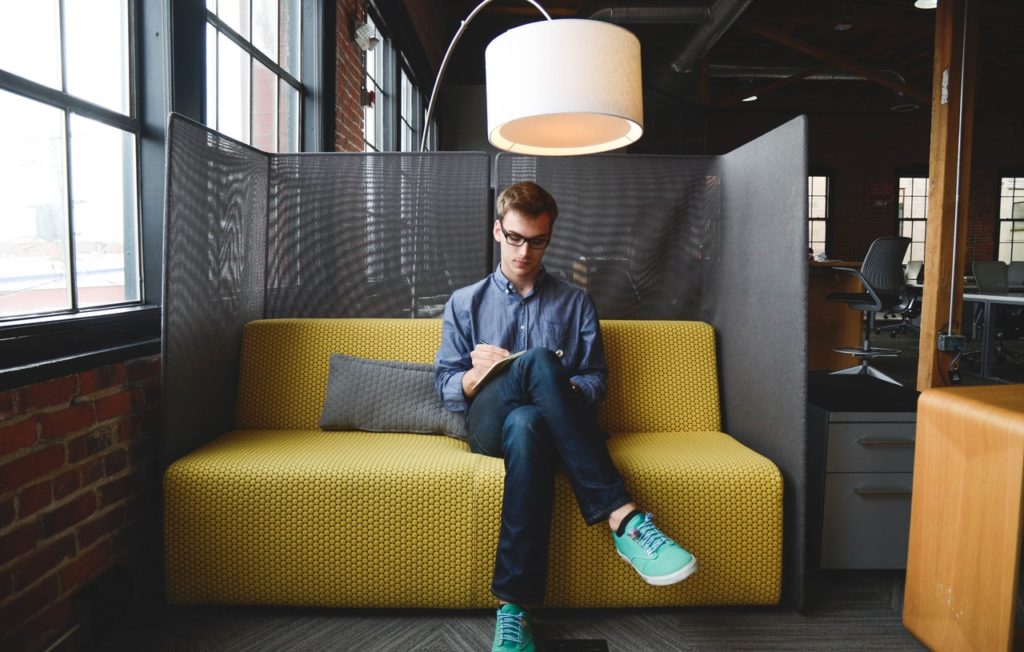02 / 03 / 2018
Office design trends 2018: How we’ll see the workplace transform
The way office spaces are designed and utilised has changed drastically over the past 10 years or so.
If we compare workplaces today to those of around a decade ago, there’s now a lot more thought being put into the way we work, and how design or re-structural changes to the office environment can boost productivity for a more efficient, happy workplace.
It’s all about making the office space a place where employees want to go to work, and this can be achieved by creating a homelier environment by making a few simple changes.
Looking for more up-to-date tips? Check out our office design trends for 2024.
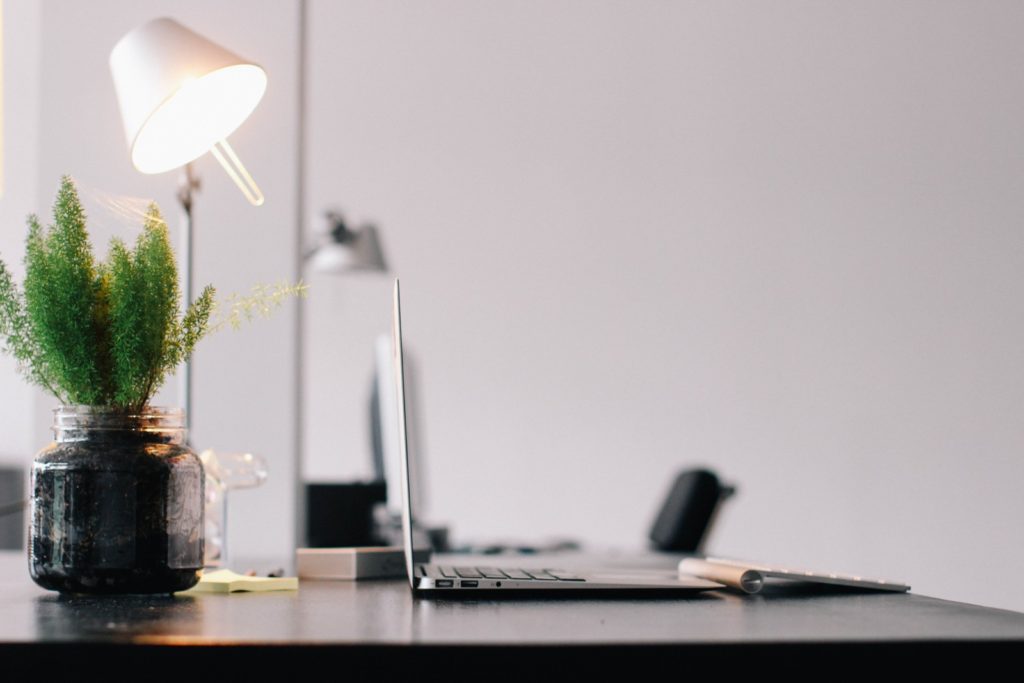
Unconventional workspaces
With advances in technology, staff are now able to work from just about anywhere, and research studies show that by having breaks from their usual desk space can actually help to inspire creativity and boost productivity. This is one of the main reasons why unconventional workspaces, have become such a big trend in many offices worldwide, by utilising and making the most of office space that you wouldn’t have otherwise considered useful. It can be as simple as having a few comfy chairs in a corner and encouraging employees to head over with a laptop to help get their creative juices flowing.
Collaborative working
Teamwork is a major key to success in any company, and encouraging more of it is only a good thing. More and more offices are working on introducing collaborative spaces where colleagues can gather, put their minds together and share ideas. To really get the most out of these areas, ensure there are plenty of tools around to help these meetings become as productive as possible – including interactive whiteboards, tablets/laptops, projector screens and comfy seating.
Biophilic designs
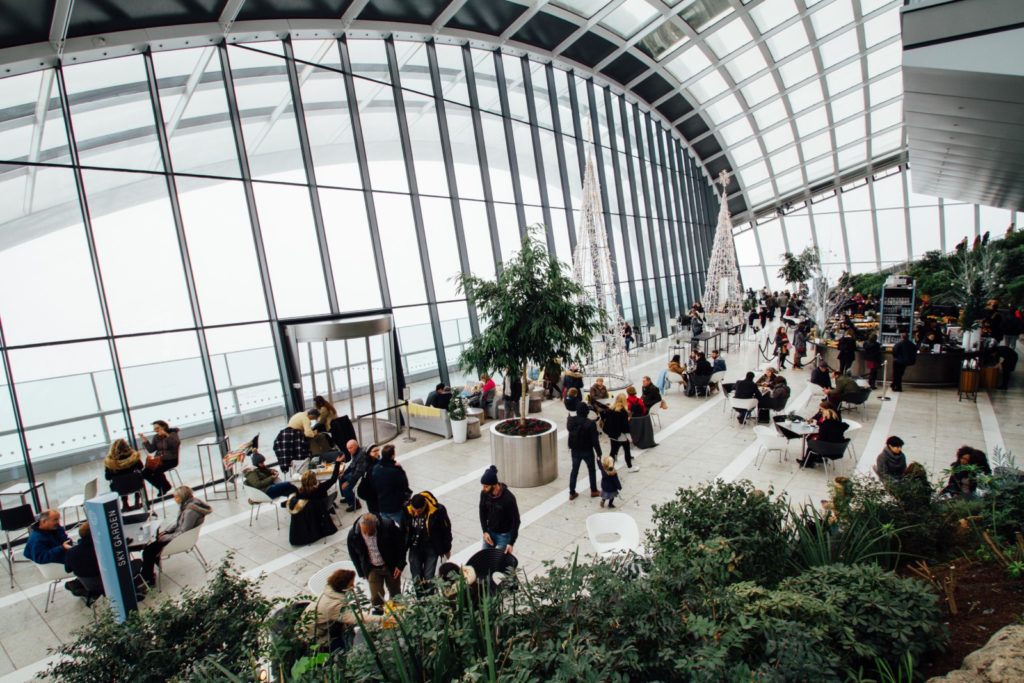
Bringing the outdoors, indoors. Biophilia is a hugely popular design trend at the moment, and focuses on incorporating elements of the natural environment into buildings, in an attempt to improve health and well-being. With the use of natural materials, textiles, patterns and colours, as well as an improvement in natural & artificial lighting, acoustic comfort, and many more elements it is thought that biophilic designs in the office can increase productivity by 8%, well-being by 13% and an increase in creativity and as a result.
Those are just a few of our ideas which we think will shape the way we work in 2018 and beyond. With that being said, we got in touch with some of the UK’s best interior designers, and asked them:
“What are the biggest office design trends we should expect to see in 2018?”
Here’s what they had to say…
Lesley Taylor – Gloss Interiors
“I think we will see further development of the breakout space, especially within younger companies that may tend to have a more flexible approach to working styles. They are looking to brands like Innocent and Google as inspiration to how spaces are used. No longer are separate meeting rooms the only places to discuss ideas and make phone calls.
These breakout areas are highly styled to reflect the age of the staff working there and we have in the last couple of years often see the ‘outside in’ trend of astroturf and picnic benches. ‘Play’ areas are becoming a feature too. I have seen boardrooms turned into games rooms by Managing Directors who want their staff to be able to connect with each other and have some fun, in this singularly ‘plugged in’ world we inhabit.”
Hayley Whitlock – Interaction
“In 2017 we saw a significant rise in the use of Resimercial design, where residential and commercial themes are amalgamated. With it set to gain further traction this year, we’ve delved deeper into why it’s popular and how it may be beneficial for workplaces.
The Resimercial design trend encompasses layouts, architecture and furniture that blend residential and domestic interiors with more traditional workplace aspects. It revolves around the liberalisation of workplace design, which puts people and their work-life balance at the centre.
By creating comfortable environments, the workplace becomes a place that staff members want to come to work in, rather than a place they have to be – which in turn, enhances productivity. This productivity underpins the trend; by working in a more comfortable space, individuals are inspired to be more creative and collaborative – factors which greatly enhance the output of work.
One of our designers, Hayley Whitlock, shines further light on the development of the trend, commenting how: “Resimercial design has grown in tandem with collaborative and agile spaces. The more workspace design has moved in that direction, the more we have seen the Resimercial trend. Every design and build project we work on is based around creating agile, collaborative and flexible working spaces that bring out the best in people – and Resimercial now plays a significant role in this too.
“A great example where we have used Resimercial recently was in our project for SunLife. The reputable Bristol-based insurance company wanted to enhance their working culture with a modern, collaborative and wow-factor space. A key part of achieving this came from utilising the Resimercial trend and combining spaces for working and downtime, in addition to one-of-a-kind finishing touches, such as a central tree. The breakout areas give a particular nod to Resimercial by offering the comfort of home in a workplace setting, with varied styles of seating, lighting and décor. The overall result is a flexible environment suitable for today’s modern workforce – and one that will encourage collaboration, creative thinking and productivity.”
Here at Interaction we’re excited to see what the future of Resimercial holds. The design team here are looking forward to using it more and more, so watch this space…”
Chris Sparham – Rap Interiors
“Following on from what was a groundbreaking year, we expect to see more exciting developments in the office design world in 2018.
One trend we expect to see a lot more of in 2018 is the ‘activity based working’ office, where employees are given a choice of workspaces to undertake a range of tasks, whether it be creative thinking or collaborative work.
This conscious effort to boost productivity through office design is a sign of things to come, with more companies now breaking down the walls in their space to improve communication. To maintain a departmental feel, some are cleverly using screens, glass partitions and furniture as makeshift department dividers.
From a purely aesthetic perspective, we expect to see more companies adopting an industrial theme. Key features of this design include exposed ceilings, graffiti style signage, pendant lights and brick-effect walls.
In addition to the above, expect to see more companies introducing an eco-friendly office design to reduce their carbon footprint, meeting pods for practicality, and fun elements like bean bag chairs and game rooms to boost morale.”
Ryan Jones – Advanced Commercial Interiors
“The biggest thing we will see with office design in 2018 is the rise of hybrid office spaces. For years now we have seen completely open environments, from the CEO to the junior employees, thanks to the open office trend. However, people are now starting to realise that this is starting to become less and less useful by the week. To replace the open office, we will see the hybrid office. The hybrid office is a mix of both open spaces, as well as closed off offices and other areas. This allows employees to be both collaborative in their work, as well as the ability to take a private conversation into a more private and closed off area.”
Michael Gorman – RSR
“With the excitement of the New Year firmly behind us and Spring on the horizon, we at RSR decided to take a look at what we think will be the top trends in commercial interiors for 2018. Whether you are planning to open a new office or looking to bring your current space up to date with a few ‘on-trend’ tweaks then we have just the insights for you on what will be the hottest design choices for this year.
Bringing Home To Work
This year will see a move away from cold, clinical design choices in interior design, with a big shift toward comfort and warmth when it comes to colours, furniture and overall styles. This year, less very much means more when it comes to contemporary designs. Simple, elegant style is always a winner but this year there is also a big focus on creating welcoming spaces which bring people in with warmth, feeling and even a little eccentricity rather than the slick, polished or standoffish interior designs seen in previous years.
Eco Style
In line with the overall feeling of welcoming and homely spaces that are key to this year’s designs, recycled materials are perfect for all types of furniture and style accents in your business. Reclaimed wood, metals and natural textures can really complement designs that are both welcoming and eco-friendly. Just as ostentatious shows of wealth and opulence are on the way out, the trend for 2018 is heading towards a more considered approach where materials have been up-cycled or repurposed from their original function. This can also really help to bring a feeling of uniqueness, individuality and charm to your working spaces.
The Outdoors, Indoors!
Considering that 2018’s interior design trends centre on natural textures and materials it should be no surprise that Mother Nature makes an appearance in this year’s style choices. Anything from a humble pot plant to big and bold areas of lush foliage can work to create a design that’s inviting and can make any commercial space feel like an eco-friendly haven. All of this greenery doesn’t have to just fill your desk and floor spaces either, as there’s a whole world of opportunity for using both plant images and plant pattern prints in your style choices. Branching out with some planters can also help to generate an “au naturel” atmosphere – not to mention some extra O2 – to your interior designs.
It’s All About The Feels
The overarching theme of warmth and cosiness for 2018 means that the use of textiles will be done in a plush and comfortable way too. The emphasis will be on welcoming comfort and homely relaxation so large soft sofas and armchairs which invite you in and that you can relax into are going to be a must-have for areas where visitors will be welcomed, or for breakout areas where staff can collaborate in comfort. If your needs and tastes are headed toward more rigid furniture, then why not try adding some extra upholstery or even a few well-stuffed cushions to increase the comfort factor. Textures for 2018 are going to involve natural fibres, although plush, velvety finishes can also complement your other choices if you want to combine both elegance and warmth.
It’s Not All Soft, Though…
Although everything we’ve mentioned so far has focused on cosy homeliness and the trend this year toward plush comfort and warmth, you might wonder how the harder materials, like ceramics, glass and metal, can work in your commercial interior design. This isn’t a problem, if you keep with the idea of warmth you can still incorporate almost any material choice and it will work. As examples, terracotta, marble or natural stone are a great choice for tiles and rustic pottery vases, while glass should be visibly recycled or reused in an imaginative way, following the styles mentioned in the ‘Eco Style’ section. Lastly, warm metals like gold, rose gold or brass will match in well, while silver can add an element of brightness if needed.
Out Of The Darkness And Into The Light
This year’s emphasis on cosy, warm spaces that remind you of home might give the impression that you need dim lighting to create these environments – not at all! Striking lighting designs are an ideal way to step out of the potential gloom, leaving the contrast of things like natural woods and ceramics positively glowing under high-intensity lighting. Generally, these should be highlighted using the focused luminescence of spot lighting, rather than the flat and far less interesting (though functional) LED panel lighting. Allowing darker accent corners or harder to light areas, whilst including a few, well-placed desk or table lamps can give a real depth to your spaces. Over-the-shoulder reading lamps can also add to the features in break areas or lounges.
So What About Colour?
Unsurprisingly, the most popular colour palette for 2018 is strongly in the warm part of the spectrum. Reds and associated colours, like oranges, warm yellows and even pinks, are definitely the trend this year. Red has always been associated with heat, positivity and energy so this is the colour to use if you want to bring a positive vibe to your commercial interior designs in 2018. For maximum effect, try using several tones from a range of warm colours – this way you’ll avoid everything becoming too flat and you’ll be able to bring some life to your commercial space. Complementary shades of red can work well together – bright splashes of colour can lift a range of more neutral natural colours or can be used in a wider area to add some real drama to your space.
Keeping It Cool
If you’re looking for something slightly cleaner and fresher in your interior design, then a great alternative is the surprisingly warm shade of teal. Although this falls into the opposite side of the spectrum to the ‘on-trend’ colours of red, orange and yellow it can be sophisticated and elegant, without being as cold or standoffish as some of the other turquoise tones can be. If you’re smart in how you make use of this colour, alongside natural textures and materials, it can really lift your spaces without overpowering them.”
Carys Berrow – Powell
“Biophilia in definition means the ‘love or life of living systems’ and it focuses on the ideology that humans possess an innate tendency to seek connection with nature and other forms of life. Biophilic design is an extension of this theory and idealises the introduction of natural forms into working environments. Natural light, organic structures and biocolonizable textures are all part of this emerging style.
This type of design isn’t a new concept, it’s been around for a while and applied by the likes of well-known Architect Ludwig Mies van der Rohe and more recently Oliver Heath, who last month, led a Biophilic workshop in Cardiff, introducing fresh ideas to young, talented designers.
Our very own Interior Designer, Carys Berrow, attended the workshop and notes how using our outdoor surroundings to enthuse an interior space is a great way to encourage positivity in the workplace. She says, “Using materials and colours from natural origins, introducing variations that can be found in the leaves of a tree or a sunset, helps create a holistic space that makes people feel comfortable.”
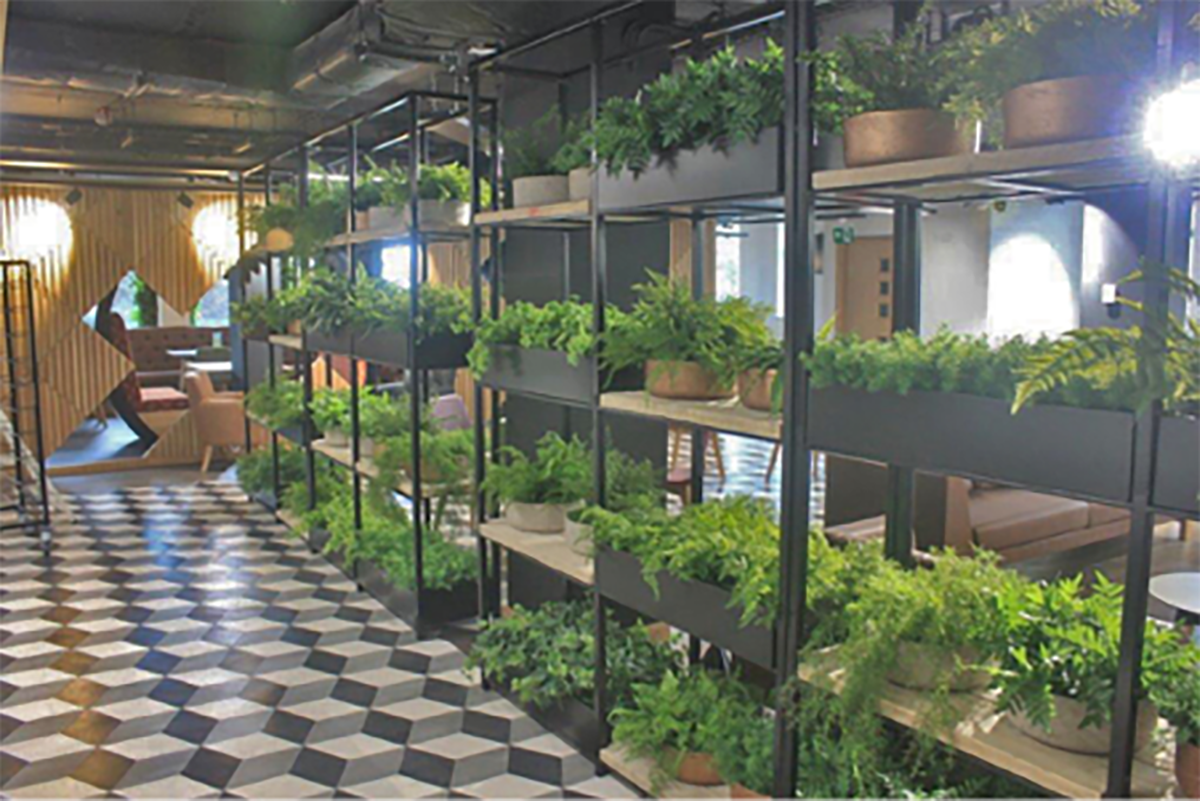
Now, connecting with nature may not be everyone’s cup of tea; however, it’s been proven that this type of design has a positive effect on those in a working environment. Research has found that there is a strong correlation between staff performance and the environment we work in. According to the BRE (Building Research Establishment), in a biophilic office environment there are quantified improvements in productivity, wellness and a reduction in days absent due to illness. Statistically, even with just a 1% reduction in absenteeism, the lost days alone would save the UK economy approximately £1 billion a year. Meaning that staff are not only profiting emotionally, but employers will feel the benefits too!
To embrace biophilia, it doesn’t necessarily mean your office has to be full of foliage or covered in murals of greenery – sometimes only small changes can be made. Simply opening up a space to introduce more sunlight, or arranging desks to reflect an organic formation, are small steps that could improve staff well-being and performance. Carys says, “There needs to be some connection to the outdoors, even if it’s not obvious. Introducing glass partitioning will allow natural light to flow into the space from exterior windows, or continuing an exterior stone flooring into the interior workspace is another great way to bring the outdoors in.”
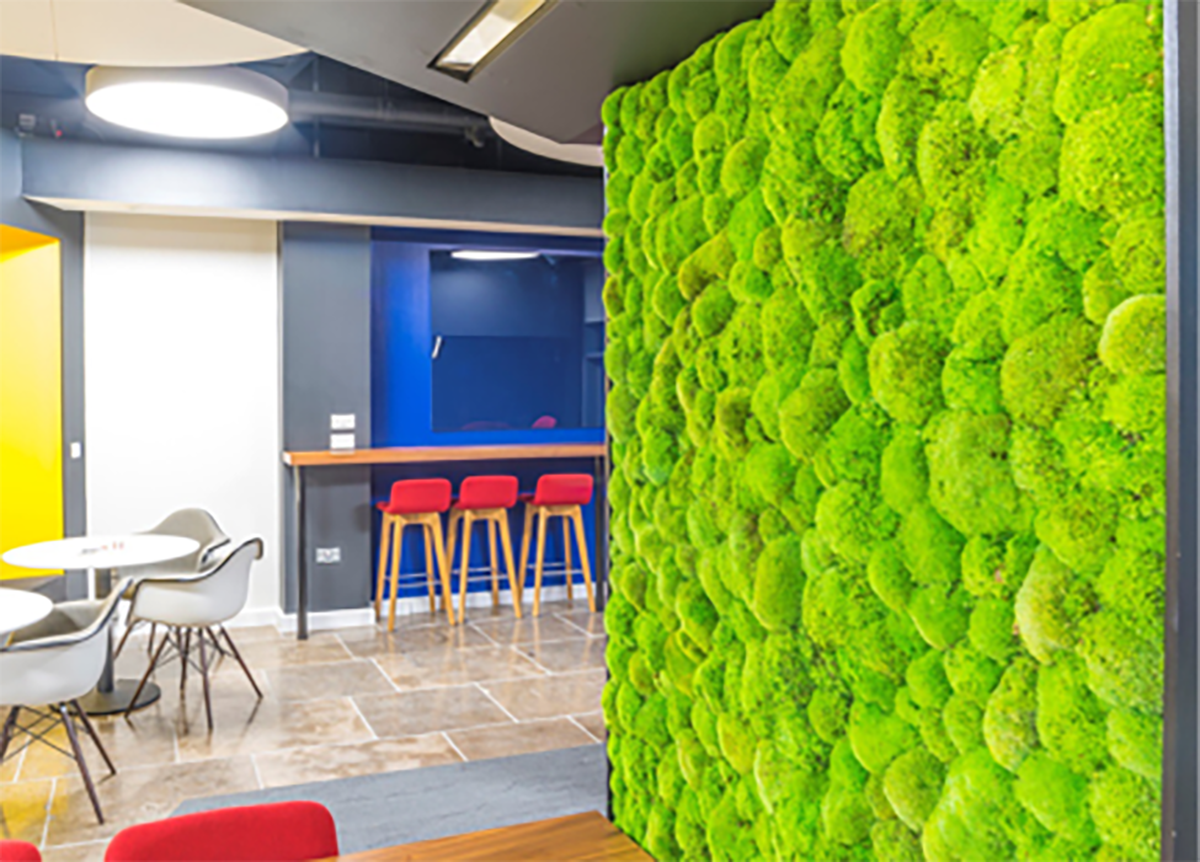
Providing different areas where people can work, naturally promotes agile working and increases staff collaboration – something we know is key in modern workplaces. These areas are usually implemented through working pods, soft seating or high benches, coupling this with textures that mimic natural materials or forms is key in a biophilic space. It’s possible to even go as far as implementing a biocolonizable area, like a living wall – which can be seen here at Welsh Government: Merthyr Tydfil.
Everyone has their own preferred way of working, but by providing alternative areas that include elements of our natural surroundings, can help improve the office experience as a whole and create an environment staff are happy to be in.
If you’re interested in biophilic design and looking to update your working environment, give us a call on 02920 23 23 23 or contact our interior designer Carys via email, carys@powell.co.uk.”
Jeff Shields – Flooring Supplies Direct
“2017 was an interesting year for the change in office design, and we think that things will only continue to evolve throughout 2018. We’ve noticed an increased need for dynamic spaces in workplaces throughout the UK, to provide more movement within the office.
It’s becoming very important for companies to avoid their employees becoming creatures of habit when it comes to their working environment. With more and more focus being placed on the well-being of staff, it’s clear to see that sitting in the same chair for an 8-hour day at work isn’t beneficial to anyone. With the simple introduction of sit-stand desks, moveable furniture or areas to breakaway from conventional desk spaces, it’s easier for staff to get up and move around, stand up to take calls and feel more inspired by the environment around them.
By taking down the dividers and opening up the office, you can easily create a more welcoming, collaborative atmosphere that can increase energy and creativity, to make for a happier workforce.”
Rhino Interiors Group
“The perception of the office environment is shifting from that of a premises to an ‘experience’. But what does that mean and how can you make the most of your workspace to make the people inside do their best work?
Today’s research shows us that offices should be based around our activities and the office setup must be adaptable to our working preferences, which is based on our personalities — this means one office layout does not fit all. New ways of organising the office, including Activity Based Working (also often referred to as ‘agile working’), and hot-desk layouts, give people control over how, when and where they work. Crucially, physical changes to workspaces need to be based on accurate data, such as monitoring occupancy levels and tracking how people flow in and out of the building and use the space.
With a combination of accurate data, considered planning, and consultancy with the people using the space (employees), as well as the introduction of carefully planned flexible working policies, businesses should see an improvement in engagement and productivity, with a load of other benefits, to boot. The agile office theory breaks the workspace into four different working zones: for focus, collaboration, meeting and social. But it must be unique and based on data about occupancy, behavioural patterns, peak usage and departmental flows. Without this, no amount of theory and buzz words will work, says agile working consultant, Hannah Nardini: “There is no one-size-fits-all when it comes to agile working. Your workplace is unique and you must understand its complexities first.” Some ways to think about the four zones include pods and cabins for privacy, acoustics and concentration; informal settings for break time, project catch-ups, as well as quiet space, outdoor areas, open plan and sit-stand desks.”
A huge thanks to all of our brilliant contributors, who have given us a great insight into the future of office design trends this year.
Enjoy this article? You might be interested in some of our others:
22 / 03 / 2018
The changing face of the office workspace
Workplaces are evolving, and have been for many years. Due to advancements in technology and changes in modern design, the way we work has completely transformed.


